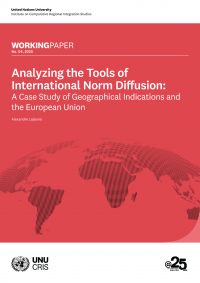Analyzing the Tools of International Norm Diffusion: A Case Study of Geographical Indications and the European Union

The European Union (EU) is increasingly explicitly engaged in a global normative agenda, aiming to become the primary rule-setter on the international scene. This strategy is pursued in a broad set of areas, through internal policymaking, diplomatic means, and trade policies. This working paper aims to critically examine the development of this strategy for geographical indications, a contested category of intellectual property rights which the EU has vested interests in promoting internationally.
Using interviews with key stakeholders, analysis of existing literature, of the relevant case law, and a systematic analysis of the content of all currently active EU trade agreements, this research provides an outlook of the variety of instruments through which the EU has pursued an agenda of diffusion of rules on geographical indications. This working paper also critically assesses the efficiency of these tools by conducting a case study of the East-Asian region (People’s Republic of China, Republic of Korea, Japan).
One key insight of this research is that the combination of unilateral, bilateral and multilateral actions appears to have been improving the effectiveness of the global diffusion of rules on geographical indication. Thus, this paper aims to contribute to the discussion on the effectiveness of the EU’s policy of normative influence, and on the interactions between the different tools used for this purpose. It also provides a comprehensive mapping of EU tools of normative influence on geographical indications.
